The Rich and Robust World of Vietnamese Coffee
Potent and rich Vietnamese coffee wins over enthusiasts as rapidly as it accelerates heartbeats. While coffee was introduced to Vietnam by French colonizers, the daily ritual of savoring coffee swiftly became ingrained in local customs. Embracing diverse adaptations incorporating yogurt, eggs, and even fruit, Vietnamese coffee has evolved into a distinct and unique style.
Each cup of Vietnamese coffee is a tribute to the craftsmanship and dedication of those who cultivate, brew, and share this beloved drink with the world. Whether sipped on a bustling street corner in Hanoi or enjoyed in a cozy cafe abroad, Vietnamese coffee invites you on a flavorful journey that goes beyond the borders and speaks to the soul of a nation.
The Essence of Vietnamese Coffee
What distinguishes Vietnamese coffee from others is the distinctive brewing style and the use of robusta beans. Robusta beans, known for their strong and slightly bitter flavor, are favored in Vietnam, contributing to the coffee's unique taste profile. The beans are often roasted with butter or fish sauce, adding an unusual but delightful depth to the brew.
However, what attributes to the robust flavor of Vietnamese coffee? While some attribute it to the drip filter, the distinctive and intense taste stems from the traditional roasting method. Vietnamese roasters often utilize rice wine, a hint of salt, and butter during the roasting process, with the latter imparting a subtle oily texture to the slow-drip coffee in Vietnam. Additionally, certain roasteries introduce flavors like chocolate or caramel, catering specifically to the preferences of local coffee enthusiasts.
How to make Vietnamese Coffee?
Making Vietnamese coffee is a straightforward process as long as you have the right ingredients at hand. Here's a recipe for How to make Vietnamese coffee that you can refer to:
-
Begin by boiling some water. Take a glass and pour one to two tablespoons of sweetened condensed milk into it. Place one or two tablespoons of ground Vietnamese coffee beans into the coffee press, securing the strainer (top) firmly.
-
Position the Vietnamese coffee press on the glass containing the sweetened condensed milk and pour the boiling water into the press's top section. Allow the coffee to drip slowly through the press, which might take a few minutes to complete.
-
Remove the coffee press and stir the coffee thoroughly to ensure it's well-mixed. If desired, add ice for an iced coffee variation. Once thoroughly mixed, your coffee is ready to enjoy.
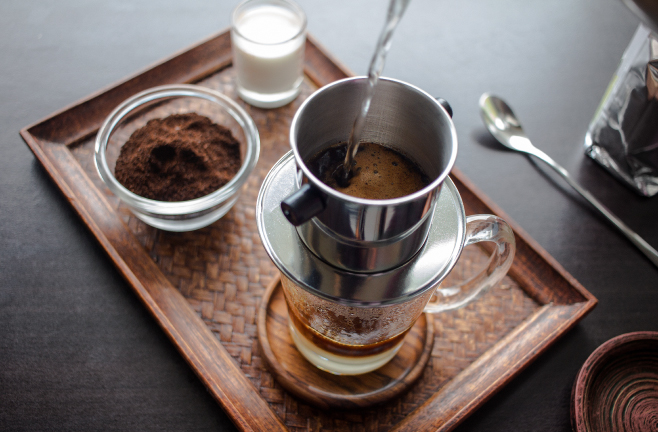
The process of making Vietnamese coffee is easy
Does Vietnamese coffee have more caffeine?
Yes, Vietnamese coffee often contains more caffeine compared to some other types of coffee. The predominant coffee bean used in Vietnam is robusta, which typically has a higher caffeine content than arabica beans, commonly found in many other coffee-producing regions. Robusta beans, favored in Vietnamese coffee, tend to contain almost double the caffeine levels of arabica beans on average.
However, the caffeine content can vary based on factors such as the type of beans used, the ratio of coffee to water, the brewing method, and the serving size. Overall, Vietnamese coffee often packs a more robust caffeine punch compared to some other coffee varieties.
Different Famous Types of Vietnamese Coffee
Vietnamese coffee encompasses a diverse array of flavors and preparations, each offering a unique sensory experience. Here are some of the distinctive types:
1. Vietnamese drip coffee
Cà Phê Phin or Vietnamese coffee phin represents a quintessential coffee in Vietnam brewing method that embodies tradition and meticulousness. This method utilizes a Phin, a traditional drip filter composed of a perforated insert that sits atop a cup or glass. Coarsely ground coffee is placed within the Phin, followed by a thin press to compress the grounds. Hot water is then poured over the coffee, allowing for a slow, deliberate drip process. This patient extraction results in a full-bodied and robust brew that showcases the unique flavors of Vietnamese coffee beans.
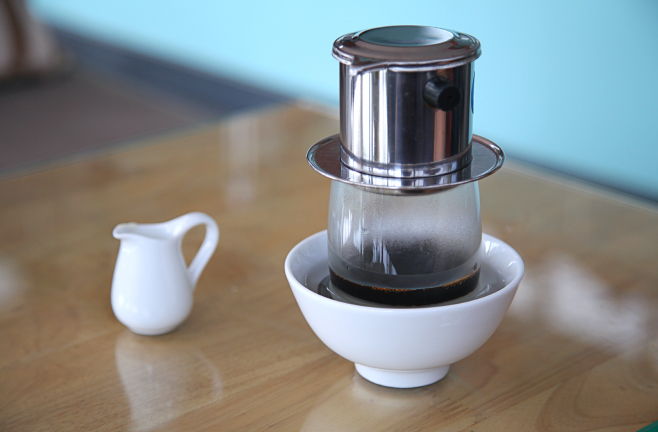
Vietnamese drip coffee
2. Vietnamese iced coffee
Vietnamese iced coffee - Famously known as "cà phê sữa đá," it epitomizes a delightful fusion of bold flavors and refreshing chill. This iconic beverage was developed from Vietnam drip coffee. The addition of sweetened condensed milk poured generously over the freshly brewed coffee creates a harmonious blend of robustness and creamy sweetness.
Once combined, the concoction is generously poured over a bed of ice, instantly transforming into a cooling, revitalizing drink perfect for combating Vietnam's tropical climate. This beloved beverage not only tantalizes taste buds with its bold coffee profile and luscious sweetness but also serves as a cultural centerpiece, fostering social connections and bringing people together in the vibrant ambiance of Vietnamese coffee shops and street stalls.
Read more: Discovering The Vibrant Flavors Of Vietnamese Street Food Scene

Iced coffee is one of the most popular drinks for all Vietnamese
3. Vietnamese egg coffee
Vietnamese egg coffee - Whipped egg yolk blended with condensed milk forms a luscious froth that mingles with robust coffee, creating a decadent delight reminiscent of a Vietnamese adaptation of tiramisu. Originating in Hanoi during the 1940s as a response to milk shortages, egg coffee emerged as a creative solution, utilizing egg yolks to complement the rich coffee flavor. Café Giang, the birthplace of this indulgent drink in Hanoi's Old Quarter, continues to serve the original egg coffee. At the same time, various establishments have introduced their versions, occasionally enhancing the original recipe.
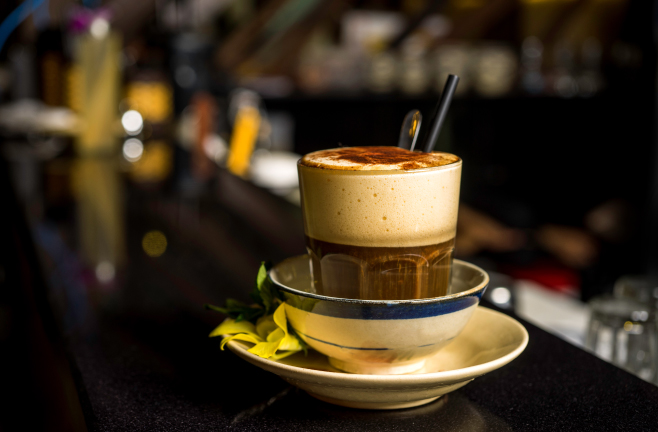
Vietnamese traditional egg coffee
4. Cà Phê Chồn (Weasel Coffee)
This is a distinctive and prized Vietnamese coffee variety that undergoes a unique and intriguing production process. This specialty coffee is crafted from beans ingested and excreted by civet cats, which are small nocturnal mammals native to Southeast Asia. After the civets consume the ripest coffee cherries, the beans undergo fermentation in their digestive system. Once excreted, these beans are meticulously collected, thoroughly cleaned, and then roasted to perfection.
This intricate process is believed to enhance the beans' flavor profile, resulting in a coffee that boasts a remarkably smooth, less acidic taste with subtle and complex undertones. Cà Phê Chồn, highly regarded for its rarity and unique production method, offers coffee enthusiasts an exceptional and sought-after sensory experience that encapsulates the essence of the best Vietnamese coffee craftsmanship.
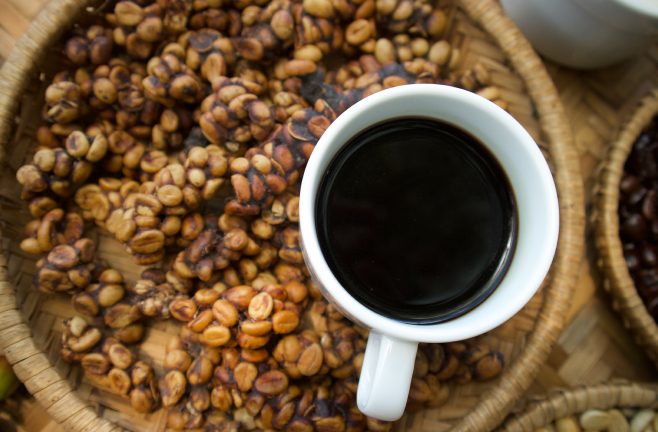
Cà phê Chồn has a unique flavour
5. Coconut Coffee
Coconut coffee Vietnamese - the origin of this recipe, whether it's a traditional method or a creation of the Cong Caphe chain of bohemian coffee establishments, remains uncertain. Nonetheless, it has garnered immense popularity among the trendy Vietnamese youth in recent years. This concoction combines black coffee infused with a hint of condensed milk, blending it with coconut milk and ice into a shake-like beverage. Another variation found in certain local establishments features a base of ca phe nau (brown coffee) combined with coconut milk and fresh milk, offering a more conventional rendition of the drink.
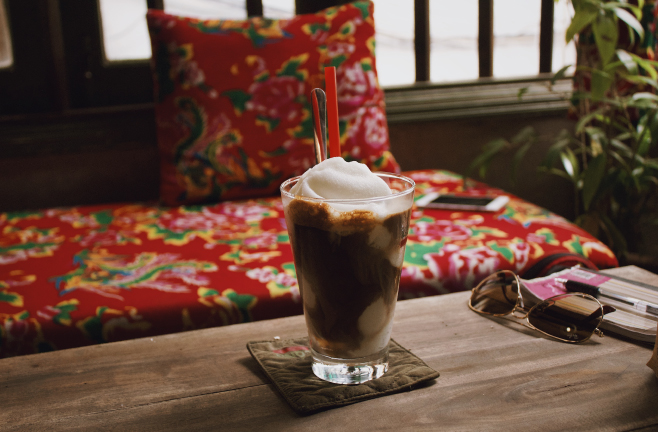
Coconut coffee
6. Yogurt coffee
Similar to coffee, yogurt was initially introduced to Vietnam by the French and has seamlessly integrated into the local culinary heritage. Its luscious and velvety texture lends itself to diverse toppings, ranging from fresh mango to fermented rice and even coffee. Despite sounding unconventional, the opulent yogurt beautifully complements a splash of black coffee—simply mix and enjoy the harmonious blend of flavors.
Where Can You Find The Most Delicious Vietnamese Coffee
Hanoi stands as the unchallenged hub of café culture in Vietnam. Despite the rising popularity of modern coffee establishments, the traditional sidewalk cafés persist in drawing patrons of all generations from sunrise to sunset, where patrons leisurely spend hours over a solitary cup. Nonetheless, exceptional coffee can be savored across Vietnam. While highlighting specific spots fails to capture the breadth of Vietnamese café culture entirely, the following addresses represent iconic landmarks in the main cities:
-
The Coffee Street Trieu Viet Vuong
-
Cafe Giang
-
Cafe Pho Co
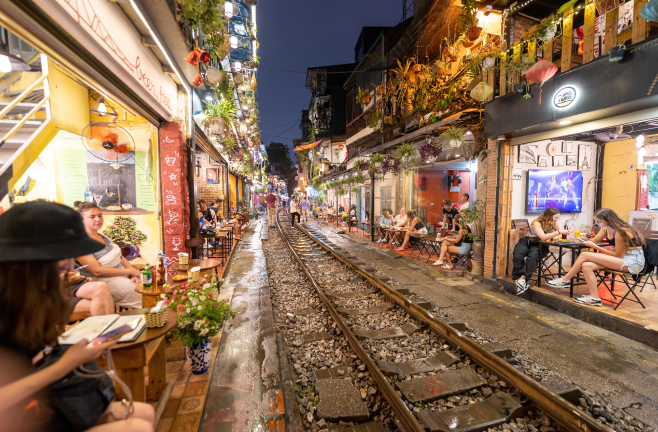
Hanoi is like a cradle of Vietnamese coffee
Conclusion: A Flavorful Journey
Vietnamese coffee is more than a drink; it's a journey through history, tradition, and taste. Its bold flavors, unique brewing methods, and cultural significance make it a true gem in the world of coffee. As this aromatic beverage continues to captivate palates globally, its legacy as a symbol of Vietnamese culture and craftsmanship remains deeply rooted in every cup.
Whether enjoyed on the bustling streets of Hanoi or at a specialty café halfway across the world, Vietnamese coffee offers a sensory experience that tantalizes the taste buds and invites everyone to savor the richness of its heritage, one cup at a time.
Related Articles
- Official Vietnam Flag: History, Meaning, Colors, and Usage
- Phu Quoc Weather: Best Time to Visit & Seasonal Travel Guide
- Moc Chau: Highland paradise of tea hills & cultural adventures
- Team building and CSR activities in Vietnam: Visa services
- Honeymoon in Vietnam: Best romantic packages for couples
- Amanoi Resort in Vietnam: Luxury retreat in Vinh Hy Bay
- Six Senses resorts in Vietnam: Ninh Van Bay and Con Dao
- Con Dao Island: A historical and natural paradise in Vietnam
HOW CAN WE HELP?
APPLY WITH CONFIDENCE










